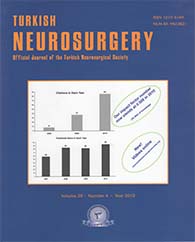2Dokuz Eylul University, Faculty of Medicine, Department of Anatomy, Izmir, Turkey DOI : 10.5137/1019-5149.JTN.3303-10.1 Aim: The microanatomy of the abducens nerve (AN) is important for clinical reasons and surgical approaches as it is located in the petroclival region. The incidence of branching and duplication of the abducens nerve are unknown and mechanisms relating to paralysis of the nerve in indirect conditions are yet to be clarified.
Material and Methods: Microanatomical details (anatomical observations and morphometric measurements) of the AN were obtained from 20 cadaveric skull bases (40 specimens).
Results: 55% of the intracranial abducens nerves had branching, with type 2 and 3 branching occurring in 10%. The nerve coursed below the petrosphenoidal ligament in all but one, and was located at the lateral third below the ligament in 82.5% of the specimens. The mean AN diameter was 1.3±0.2 mm, and the mean diameter of the dural entrance pore was 1.8±0.3 mm, the right being significantly larger than the left. The mean distance of the AN from the posterior clinoid process was 8.4±2.5 mm and from the petrous apex 3.6±2.1 mm.
Conclusion: Branching of the AN was present in a significant number of specimens; the branching pattern at the cavernous segment may be called “pseudobranching”. The AN is at risk for paresis in indirect conditions because of its angles and fixations on its course.
Keywords : Abducens nerve, Skull base surgery, Microanatomy




